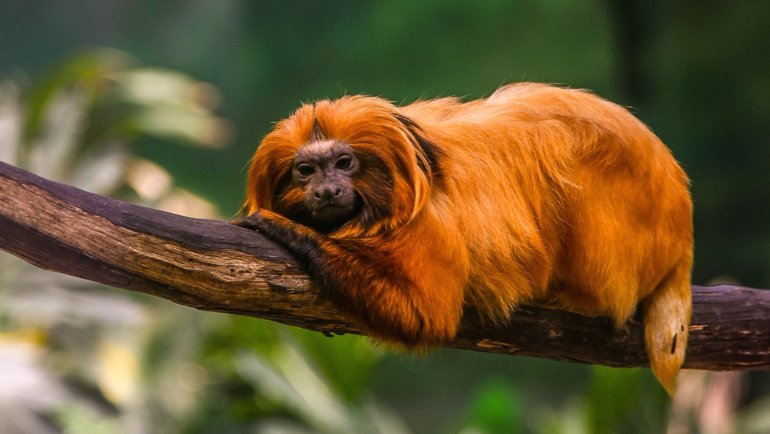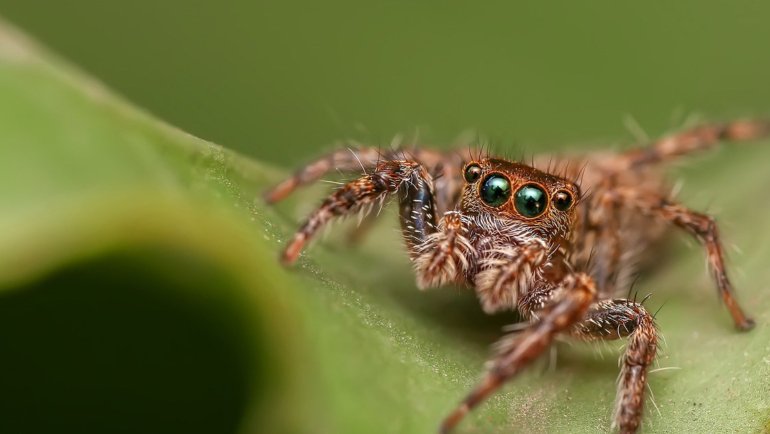Welcome, wildlife enthusiasts and animal lovers, to our fascinating journey across the globe where we uncover the captivating world of black and white animals!
From the snowy Arctic to the balmy tropics, we’re spotlighting twenty marvelous species that are draped in nature’s chicest color palette – black and white. These extraordinary creatures, shrouded in dramatic contrasts, not only captivate us with their striking aesthetics but also boast unique behaviors and adaptations that enable them to thrive in their respective habitats.
So sit back, get comfortable, and let’s dive into this captivating world of monochrome magic!
20 Black and White Animals: Overview
- Giant Panda
- Zebra
- European Badger
- Eurasian Magpie
- Malayan Tapir
- Humboldt Penguin
- Orca / Killer Whale
- White Tiger
- Striped Skunk
- California Kingsnake
- Giant Leopard Moth
- Common Eider
- Humpback Grouper
- Polka-Dot Nudibranch
- Downy Woodpecker
- Black-and-White Ruffed Lemur
- Black-and-White Colobus
- Tasmanian Devil
- Humbug Damselfish
- Wandering Albatross
Black and White Animals: Pictures and Facts
Giant Panda

- Scientific name: Ailuropoda melanoleuca
- Type of animal: Mammal
- Where found: Central China
Kicking off our list with one of the most iconic black and white creatures, the Giant Panda. Endemic to south-central China, these gentle giants are much adored for their chubby physique and distinctive black patches around the eyes, ears, and across their robust bodies. The black and white fur serves a functional purpose as well, aiding in camouflage amidst the snow and rocks.
But it’s not just their appearance that’s captivating. An intriguing fact about pandas is their unusual diet. Unlike other bears, these creatures subsist almost entirely on bamboo, spending up to 14 hours a day munching and crunching, consuming up to 12.5 kg to meet their energy needs!
Giant Pandas are a conservation success story, with their status being upgraded from ‘endangered’ to ‘vulnerable’ on the IUCN Red List in 2016. This was due to a significant increase in their population in the wild, a result of China’s tireless efforts in preserving their habitat and enforcing strict anti-poaching rules.
The Giant Panda’s tale serves as a beacon of hope for conservationists worldwide and underscores the power of concerted conservation actions.
Zebra

- Scientific name: Equus quagga, Equus zebra, Equus grevyi
- Type of animal: Mammal
- Where found: East & Southern Africa
As we trot onto the expansive savannas of Africa, we encounter the strikingly patterned Zebra. Sporting a unique coat of black and white stripes, zebras are perhaps one of the most recognizable mammals in the world. But did you know that these intricate patterns are as unique as human fingerprints, differing in width, spacing, and direction among individuals?
There are three species of zebra: the Plains zebra, Grevy’s zebra, and the Mountain zebra. While these graceful creatures share a common color palette, they each have distinctive stripe patterns and body shapes. Scientists theorize that these vivid stripes may serve multiple purposes – from camouflage and confusing predators to heat management and even social interactions.
Zebras are gregarious animals, often seen in large herds, and display complex social behaviors. They’re incredibly mobile, embarking on long migratory patterns to seek out the best grazing areas during different seasons. Despite their peaceful demeanor, zebras are far from defenseless. A kick from a zebra can be lethal, warding off any predators that dare to threaten them.
European Badger
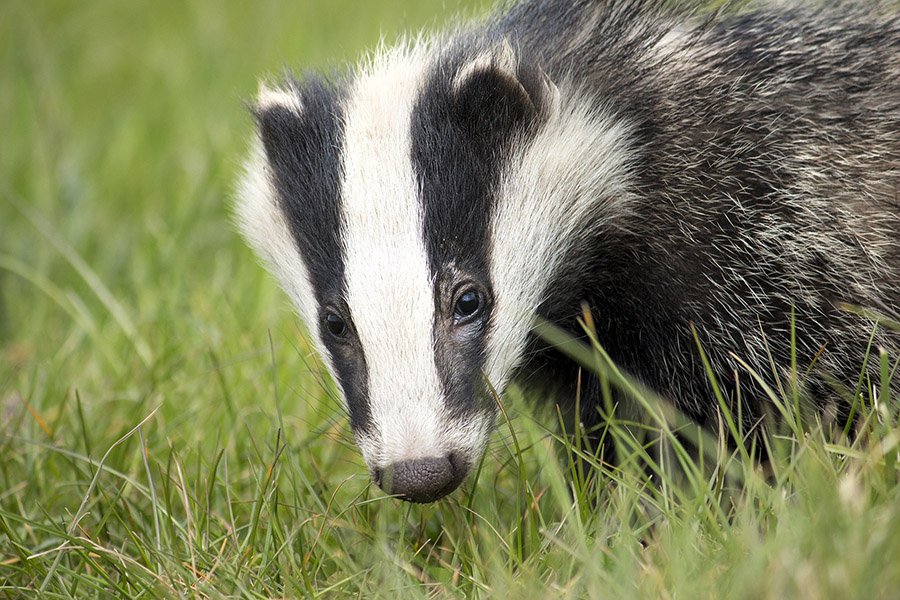
- Scientific name: Meles meles
- Type of animal: Mammal
- Where found: Europe
Our journey now takes us into the twilight world of the European Badger. Sporting a distinctive black and white striped face, a grey body, and dark legs, these burrowing mammals are a familiar sight across Europe and parts of Asia.
European badgers are known for their complex, extensive burrow systems called setts, which they dig with their strong claws. Some setts are centuries old, passed down through generations of badgers. These nocturnal creatures live in family groups and display a unique social structure, where adults share childcare duties.
Their omnivorous diet ranges from earthworms, insects, and small mammals to fruits and nuts, revealing their adaptability to various environments. Interestingly, badgers are known to engage in a peculiar behavior known as ‘latrine use’ where they utilize specific areas to defecate, either for communication or as a form of territorial marking.
Unfortunately, their numbers have declined due to habitat loss and hunting. In the UK, they have been at the center of a debate over their role in transmitting bovine tuberculosis to cattle. Nevertheless, with protective legislation in place in many countries, the future looks hopeful for these charming, nocturnal creatures.
Eurasian Magpie
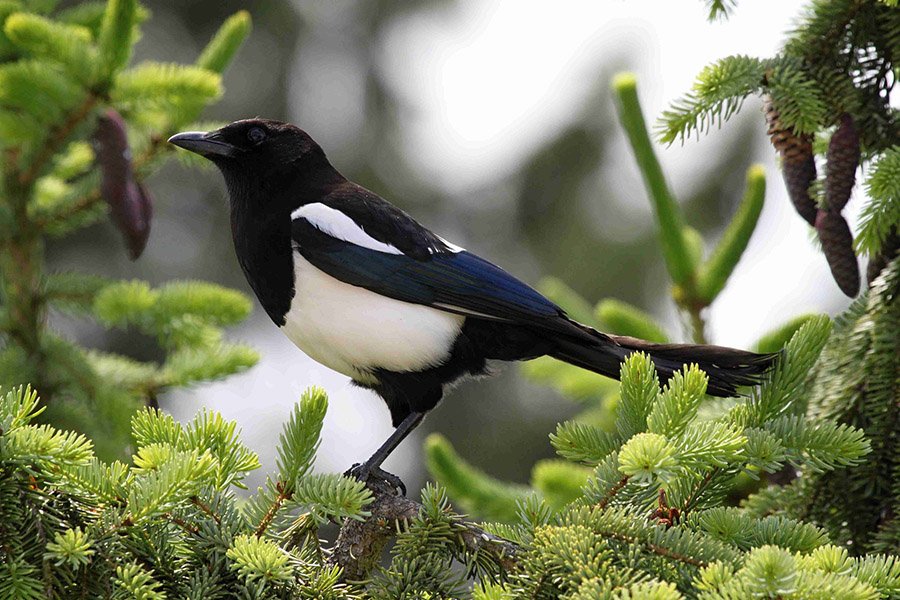
- Scientific name: Pica pica
- Type of animal: Bird
- Where found: Eurasia
The next stop on our monochromatic journey is with the ever-intelligent and intriguing, Eurasian Magpie. With its glossy black plumage contrasting sharply against a white belly and shoulder patches, this bird is one of the most recognizable in the corvid family. Native to Europe, much of Asia, and parts of North Africa, the magpie’s diverse range is a testament to its adaptability.
The Eurasian Magpie is famous for its intellect. Studies show they can recognize themselves in a mirror, a cognitive ability that only a few animals, including humans, possess. They are also known for their curious nature, attracted to shiny objects, which they often collect and hoard.
In terms of social behavior, magpies are monogamous and are known to mourn their dead – another trait that places them in a select group of animals that exhibit such behavior. Despite their cunning and intelligence, magpies often fall victim to superstition and folklore, with various cultures attributing to them qualities ranging from good luck to omens of bad tidings.
Malayan Tapir
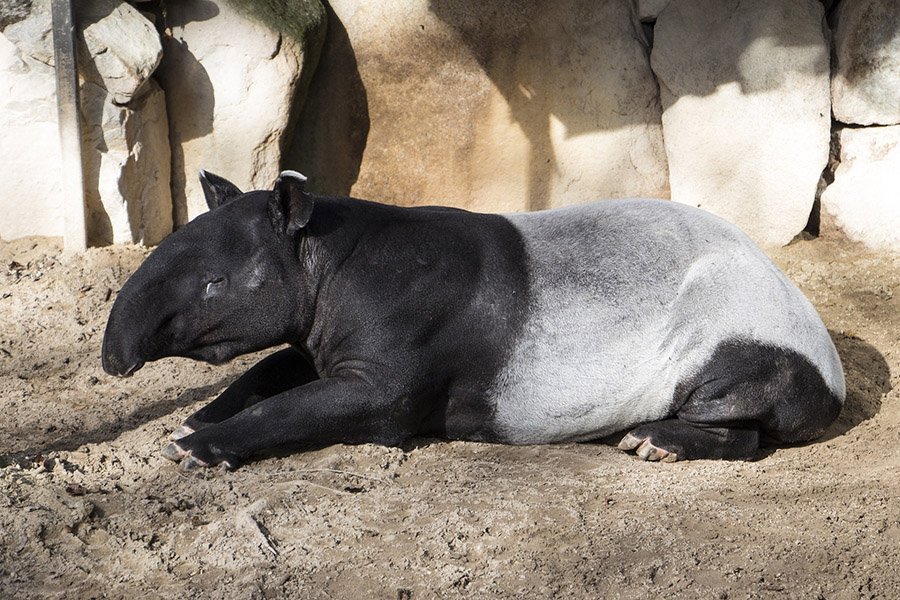
- Scientific name: Tapirus indicus
- Type of animal: Mammal
- Where found: Southeast Asia
Venturing into the lush rainforests of Southeast Asia, we encounter the Malayan Tapir. As the only extant species in Asia, it is larger than its Central and South American cousins and sports a distinctive two-tone black and white coat that aids in camouflage. The front and back of the tapir are black, while its middle section is white or light grey, breaking up its body shape in the dappled light of the forest floor.
Tapirs are an evolutionary marvel, having changed little over millions of years. With their characteristic long, flexible snouts, they forage for leaves, shoots, and fruits. Their snout is a multipurpose tool: it’s used to pluck juicy leaves, sniff out danger, and even as a snorkel when swimming!
Despite their slightly comical appearance, the Malayan Tapir faces serious threats from habitat loss and hunting, pushing them into the endangered category. Conservation efforts are underway to protect these unique creatures and their vital role in maintaining the biodiversity of the rainforests they inhabit.
Humboldt Penguin
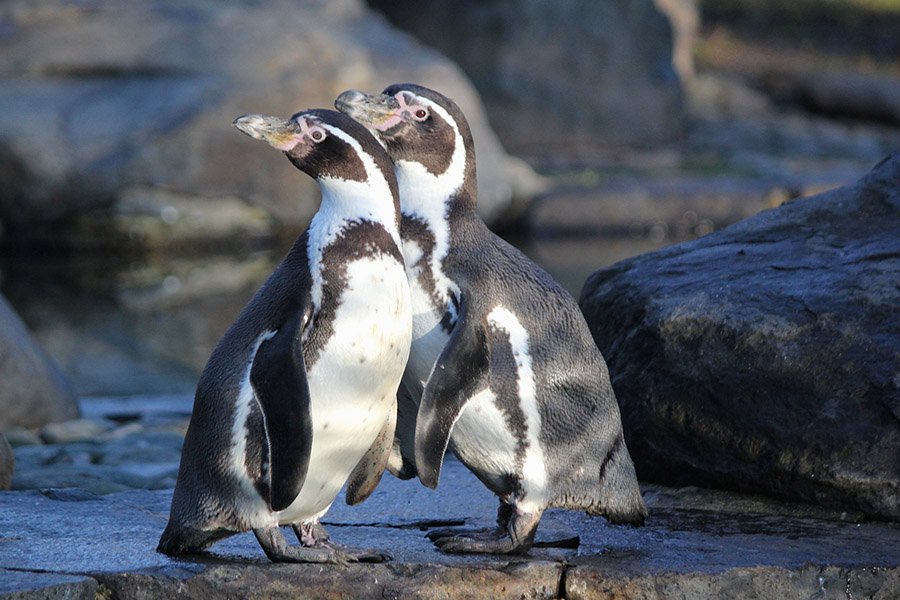
- Scientific name: Spheniscus humboldti
- Type of animal: Bird
- Where found: South America’s Pacific Coast
Our journey now takes us to the chilly currents off the coasts of Chile and Peru, where we’ll encounter the charismatic Humboldt Penguin. With their sleek black and white plumage, resembling a neat tuxedo, these medium-sized penguins are truly dashing figures. Named after the cold Humboldt Current in which they swim, these agile swimmers are built for life at sea.
Humboldt Penguins are adept hunters, diving to depths of up to 150 meters to catch fish, krill, and squid. On land, their black backs blend into the dark rocks and shadows, while their white bellies camouflage them from predators lurking beneath the ocean’s surface when swimming. They are known for their distinctive braying call, earning them the nickname ‘donkey penguins.’
These social birds form large colonies, often returning to the same nesting sites year after year. Sadly, these penguins are under threat due to overfishing, climate change, and habitat disturbance. Conservation efforts, such as marine protected areas and sustainable fishing practices, offer hope for the future of these enchanting birds.
Orca / Killer Whale
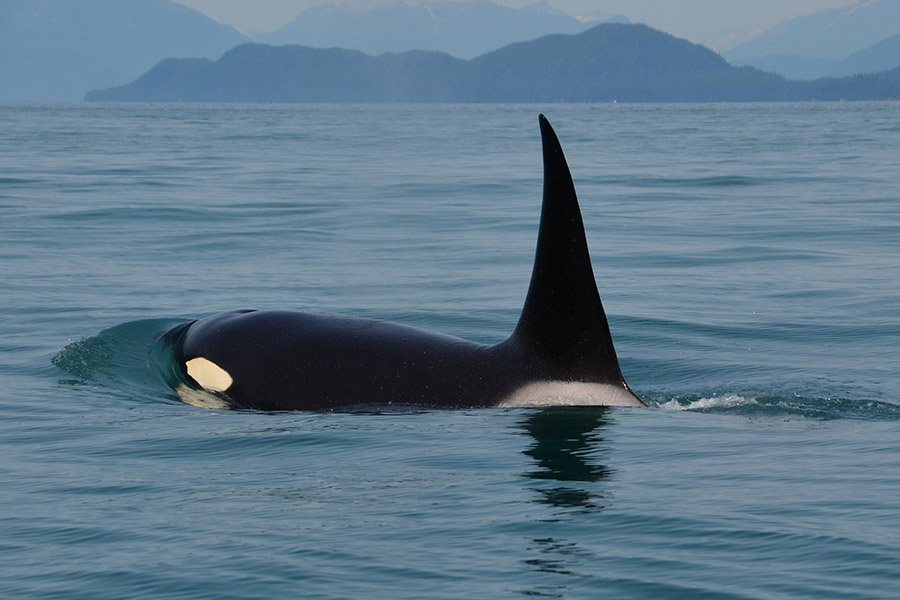
- Scientific name: Orcinus orca
- Type of animal: Mammal
- Where found: All oceans worldwide
Imposing, intelligent, and stunningly beautiful, the Orca, or Killer Whale, is next on our list. Draped in a high-contrast pattern of black and white, these are the largest members of the dolphin family. Their striking coloration isn’t merely decorative. The black and white patterns help to camouflage them, breaking up their body outline in the water, and aiding in hunting.
Orca populations display a fascinating variety of cultures, languages, and hunting techniques. Some groups specialize in hunting fish, while others hunt marine mammals like seals and even other whales. Their incredible intelligence and complex social structures are comparable to those of elephants and higher primates.
Often feared due to their name and size, these top predators play a crucial role in maintaining marine ecosystems. They are often considered a sentinel species as their health offers insights into the overall health of the marine environment. However, Orcas face numerous threats, primarily from pollution, overfishing, and habitat disturbance.
White Tiger

- Scientific name: Panthera tigris
- Type of animal: Mammal
- Where found: India
As we venture into the world of feline magnificence, we encounter the awe-inspiring White Tiger. Known for their icy-blue eyes and striking white fur striped with dark brown or black, white tigers are not a separate species, but rather a color variant of the Bengal tiger.
Their stunning white coat is the result of a recessive gene. While beautiful, it’s a double-edged sword. In the wild, their white coloration makes it difficult for them to camouflage and hunt effectively. It is believed that most white tigers would not reach adulthood in the wild due to this disadvantage.
White tigers have been revered and feared in equal measure in various Asian cultures, featuring prominently in myths and folklore. Despite their rarity and beauty, these tigers have had a complex and often tragic history, being bred selectively in captivity for their color, sometimes leading to health problems due to inbreeding.
Today, most white tigers are found in zoos and conservation parks.
Striped Skunk

- Scientific name: Mephitis mephitis
- Type of animal: Mammal
- Where found: North America
Let’s now turn our attention to a smaller, yet equally fascinating black-and-white animal, the Striped Skunk. Native to North America, these creatures are famous for their bold black and white stripes that run from head to tail and their rather potent defensive mechanism.
The striped skunk’s vivid coloration is not for camouflage but rather to warn predators of the pungent spray they can release when threatened. This powerful scent, which can be detected up to a mile away, is enough to deter most predators, including bears and wolves. Interestingly, skunks are one of the few mammals that use odor as a defense mechanism.
Skunks are omnivores, feeding on a varied diet that includes insects, small mammals, fish, fruits, and even honey. They are solitary animals, with males and females coming together only for breeding. Despite their infamous reputation, skunks play an important role in controlling pests and are a classic example of how color can be used for defense in the animal kingdom.
California Kingsnake
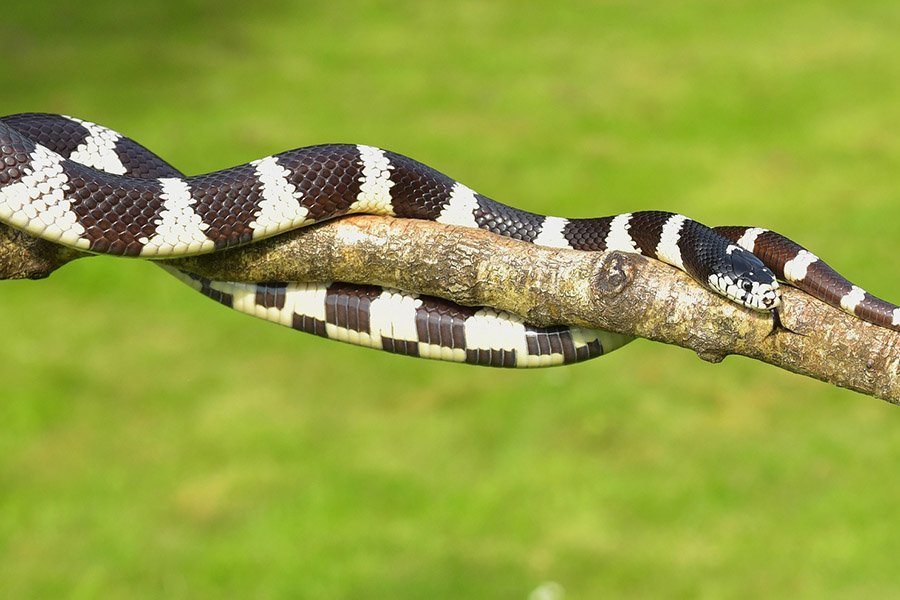
- Scientific name: Lampropeltis californiae
- Type of animal: Reptile
- Where found: Western United States and Northern Mexico
Slithering into the fascinating realm of reptiles, we encounter the California Kingsnake. This non-venomous constrictor is native to the western United States and northern Mexico.
It boasts a dramatic pattern of black and white bands, giving it a distinctive and bold appearance. Interestingly, the specific band patterns and coloring can vary depending on the snake’s specific geographic location.
The California Kingsnake gets its regal name due to its predatory habits – it’s known to eat other snakes, including venomous ones, making it the ‘king’ of its domain. Its resistance to the venom of other snakes is due to a genetic mutation, making this reptile an interesting subject for herpetologists.
Like many other snakes, California Kingsnakes are solitary animals, mostly active during the night or at dusk and dawn. While they can be intimidating due to their size and predatory nature, they are generally harmless to humans unless threatened. With the right care, these snakes can live up to 20 years, making them popular pets among reptile enthusiasts.
Giant Leopard Moth
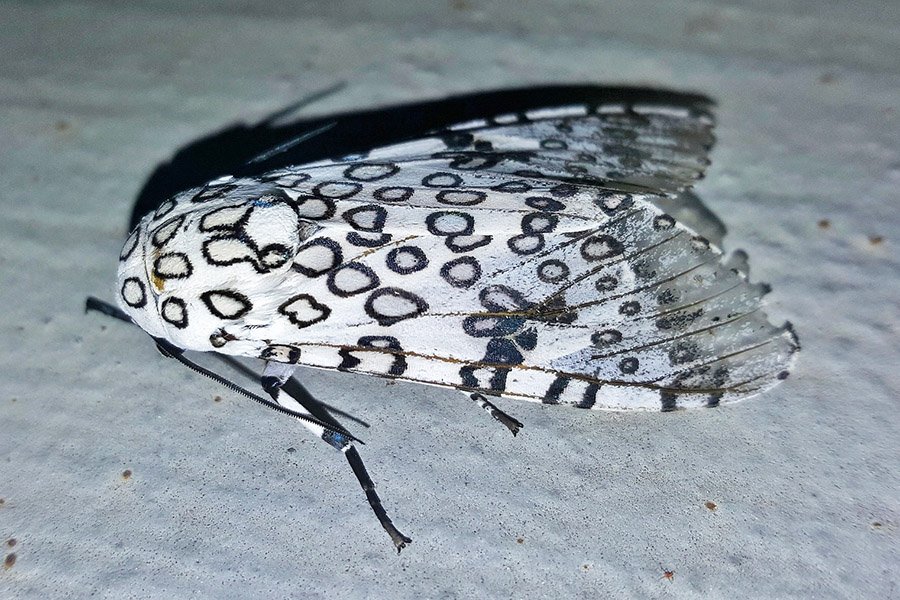
- Scientific name: Hypercompe scribonia
- Type of animal: Insect
- Where found: North America
In the enchanting world of insects, the Giant Leopard Moth stands out with its stark black and white coloration. This large and striking moth is native to North America. Its white wings are adorned with black, open-circled spots, mimicking the patterning of its namesake, the leopard.
The Giant Leopard Moth’s bold coloration is more than just ornamental; it serves as a warning to potential predators. When threatened, this moth exposes its brightly colored, blue and red underparts, signaling its unpleasant taste. This form of protection is known as aposematism, where animals use bright coloring to warn predators that they are harmful or distasteful.
The caterpillar stage, known as the woolly bear due to its dense covering of black bristles, is just as intriguing. These caterpillars have an unusual behavior of rolling into a spiral when disturbed, another defensive strategy to protect their vulnerable undersides.
Common Eider
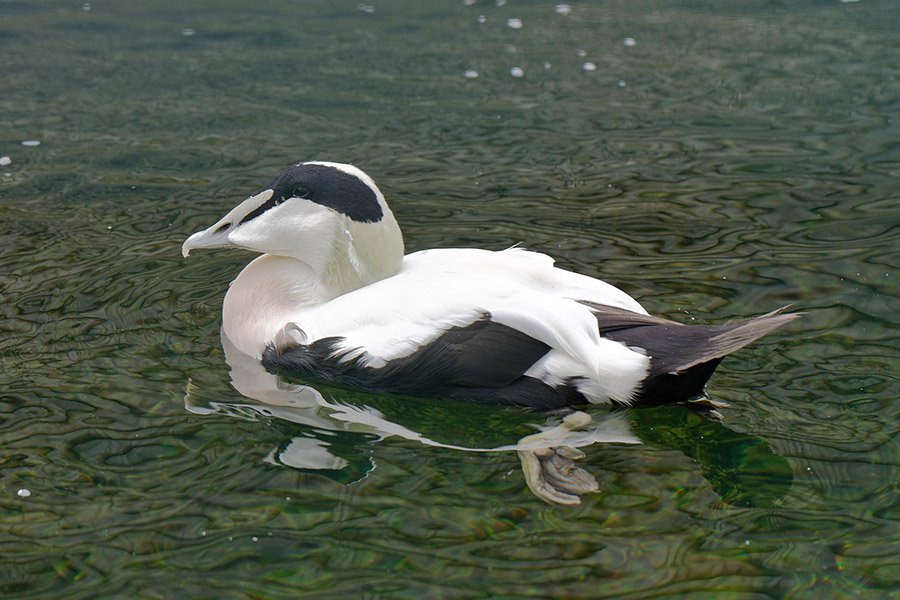
- Scientific name: Somateria mollissima
- Type of animal: Bird
- Where found: Arctic coasts
Diving into the cold waters of the northern coasts, we encounter the Common Eider, the largest duck in the northern hemisphere. These stout-bodied seabirds boast a distinct black-and-white color pattern, with males exhibiting a largely black-and-white plumage and females a mottled brown pattern.
Common Eiders are renowned for their fine, soft down feathers. The female eider plucks these feathers from her own chest to line her nest, providing insulation for her eggs. This eiderdown is incredibly effective at retaining heat, and humans have harvested it for centuries for use in bedding.
Beyond their plumage, these birds are notable divers, plunging beneath the sea’s surface to feed on mussels, clams, and other marine creatures. They use their strong beaks to pry their prey from the seafloor, often swallowing it whole. Although they face threats from oil spills and overhunting in some areas, their population remains stable due to their broad geographic range and protective legislation.
Humpback Grouper

- Scientific name: Cromileptes altivelis
- Type of animal: Fish
- Where found: Western Pacific Ocean
Our journey takes us next to the coral reefs of the Indian and Pacific Oceans, home to the Humpback Grouper. This intriguing fish is adorned with a mix of black, white, and brown patches, an example of disruptive coloration, which helps break up its shape and hide it from predators and prey alike.
Humpback Groupers are ambush predators. They use their camouflaging coloration to blend with the rocky seafloor and coral, sneaking up on unwary prey. Their diet includes small fish, crustaceans, and sometimes even small sea turtles.
Notably, like many groupers, the Humpback Grouper is a protogynous hermaphrodite, starting life as a female and later changing to a male when necessary for breeding. However, this unique species is under threat due to overfishing and habitat destruction. Ensuring the survival of the Humpback Grouper is crucial for maintaining the biodiversity and balance of the coral reef ecosystems they inhabit.
Polka-Dot Nudibranch
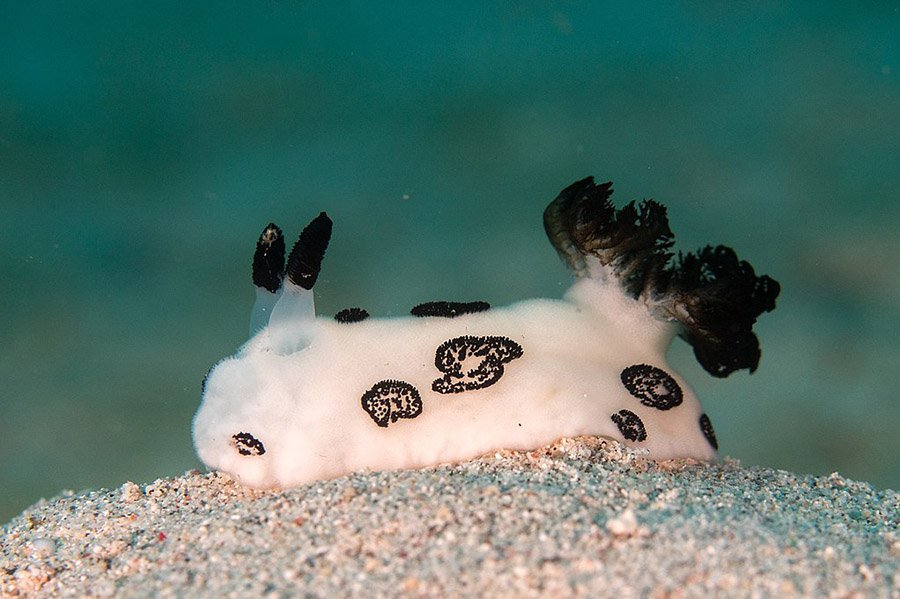
- Scientific name: Jorunna funebris
- Type of animal: Mollusk
- Where found: Indo-Pacific Ocean
Diving deeper into the world of marine life, let’s admire the Polka-Dot Nudibranch. This sea slug, native to the Indo-Pacific region, flaunts a bold black-and-white color scheme, with its body being white and its mantle dotted with black spots. The term ‘nudibranch’ comes from Latin words meaning ‘naked gills,’ describing their feathery gills and horns, which are often in bright, contrasting colors.
Polka-Dot Nudibranchs, like many of their relatives, are carnivorous, feeding primarily on sponges and small invertebrates. One of their most fascinating traits is their ability to steal the defenses of their prey. Some species can ingest toxins from their food and incorporate them into their bodies, making themselves unappetizing to predators.
Despite their small size, nudibranchs are a standout group for marine biologists and underwater photographers due to their vivid colors and intriguing behaviors.
Downy Woodpecker
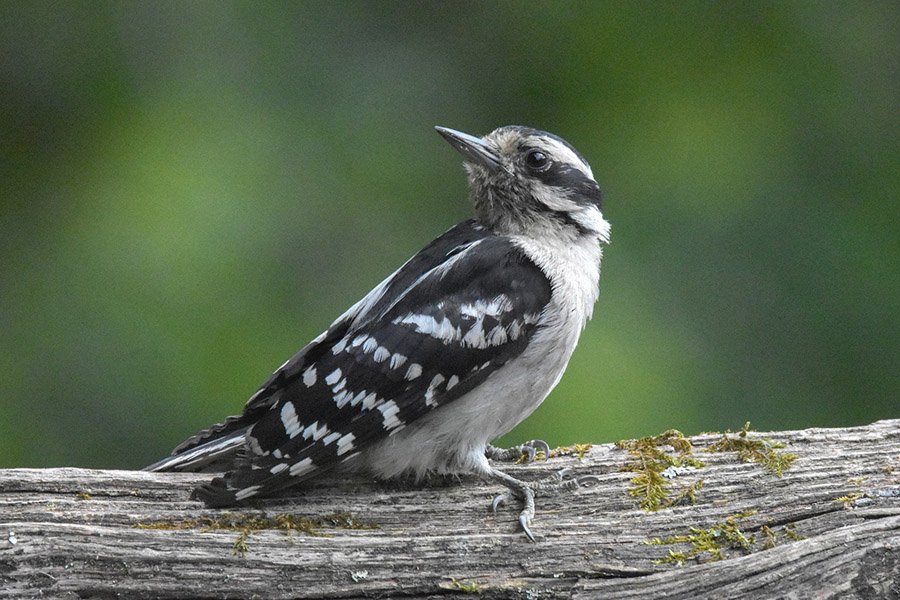
- Scientific name: Dryobates pubescens
- Type of animal: Bird
- Where found: North America
Flitting back to land, we find ourselves in the forests of North America, home to the Downy Woodpecker. The smallest woodpecker in North America, this agile bird sports a black and white body with distinct black wings spotted with white. Males have an additional dash of color with a small red patch on the back of their heads.
Downy Woodpeckers are year-round residents, able to endure the northern chill. Their diet consists mostly of insects hiding in tree bark, but they also enjoy plant material, including berries, acorns, and grains. Their unique ability to peck into the bark of trees to find food also aids in forest health by controlling insect populations.
These woodpeckers have an intriguing social behavior. While they maintain territories during the nesting season, Downy Woodpeckers are also known to join mixed-species flocks in winter, increasing their chances of finding food and avoiding predators.
Black-and-White Ruffed Lemur
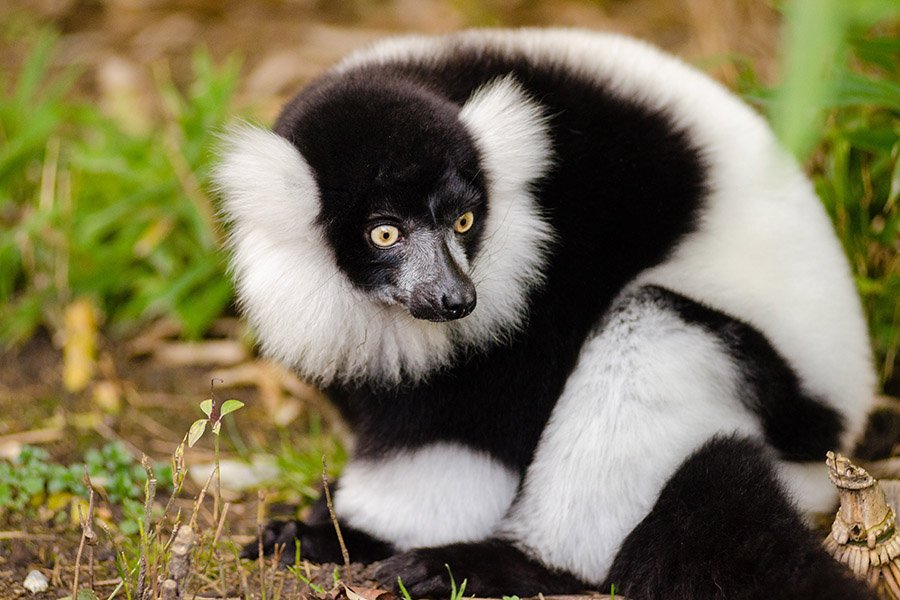
- Scientific name: Varecia variegata
- Type of animal: Mammal
- Where found: Madagascar
Venturing into the lush rainforests of Madagascar, we encounter the lively Black-and-White Ruffed Lemur. With a dramatic contrast of black and white fur and bright yellow eyes, this lemur is one of the most iconic species of Madagascar. The “ruffed” part of their name comes from the thick, fluffy fur that surrounds their face and neck.
Black-and-White Ruffed Lemurs are vital for their ecosystems as they are excellent seed dispersers, contributing to the regeneration of the forest. They are also the largest pollinators in the world, with their long snouts and tongues perfectly adapted to reach the nectar in deep flowers, getting pollen all over their fur in the process.
Despite their importance, these lemurs face numerous threats, mainly due to habitat loss and hunting. They are currently listed as critically endangered, highlighting the urgent need for effective conservation strategies.
Black-and-White Colobus
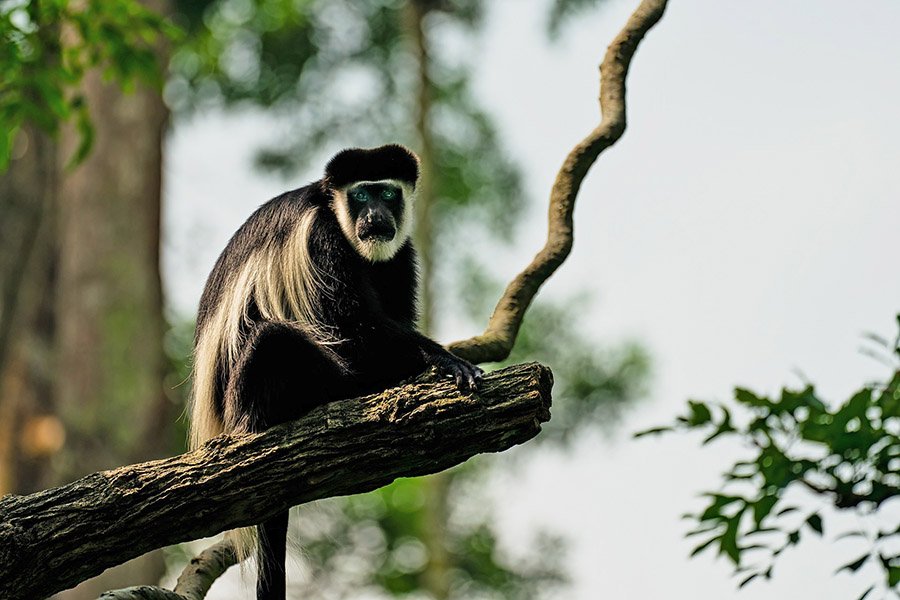
- Scientific name: Colobus spp.
- Type of animal: Mammal
- Where found: Africa
Next, we leap over to the treetops of Africa’s forests to find the Black-and-White Colobus. This primate is characterized by a coat of black fur contrasting with a mantle of long, white hair that extends from their shoulders down to their back and tail. There are several species of black-and-white colobus, each with slightly different patterns.
Black-and-White Colobus are one of the most arboreal of all African monkeys and rarely descend to the ground. They have a unique adaptation to aid their treetop life: they lack thumbs, allowing for a stronger, more streamlined grip on branches as they swing through the trees.
These colobus monkeys have a complex social structure, living in groups with a single male and multiple females. They are also known for their allomothering behavior, where infants are cared for by females other than their mothers.
Tasmanian Devil
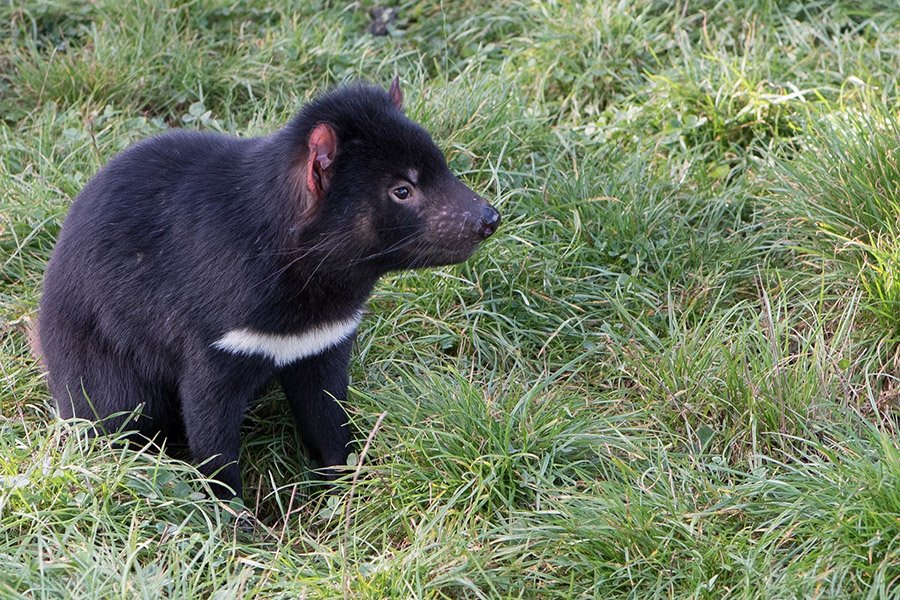
- Scientific name: Sarcophilus harrisii
- Type of animal: Mammal
- Where found: Island of Tasmania (Australia)
Let’s journey now to the rugged wilderness of Tasmania, the exclusive home of the infamous Tasmanian Devil. The largest carnivorous marsupial in the world today, the devil has mostly black fur, which is highlighted by irregular white patches on its chest and rump. These spots are unique to each individual, just like human fingerprints.
Tasmanian Devils are known for their powerful jaws and rowdy behavior. They have the ability to devour entire animals, bones and all, leaving virtually no waste. Despite their fierce reputation, these creatures play a crucial role in their ecosystem, helping control populations of invasive species and cleaning up carrion.
Sadly, the devils have been plagued by a rare, contagious form of facial tumor disease, causing a significant decline in their numbers. Intense conservation efforts are ongoing, including captive breeding programs and disease research, to ensure these iconic creatures continue to rule the Tasmanian landscape.
Humbug Damselfish
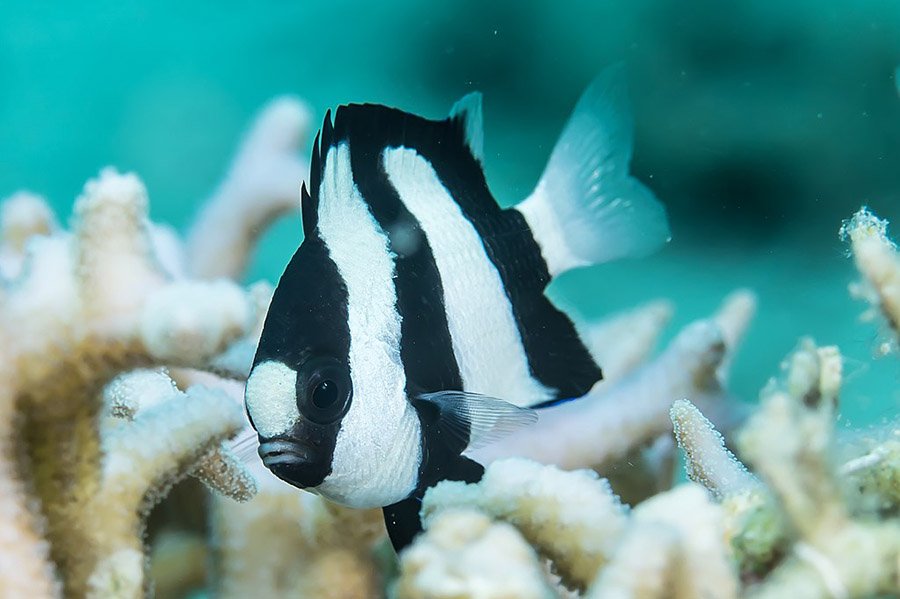
- Scientific name: Dascyllus aruanus
- Type of animal: Fish
- Where found: Tropical Indo-Pacific Ocean
Next, we return to the sea to meet the Humbug Damselfish, a common sight on coral reefs in the Indo-Pacific region. This small fish, with its striking black and white vertical stripes, may not be the biggest creature on the reef, but it is certainly one of the boldest.
The distinctive stripes serve to confuse predators and can change in intensity based on the fish’s mood or perceived threat.
Humbug Damselfish are known for their feisty and territorial nature. Despite their small size, they’re not afraid to stand their ground, defending their patch of coral from other fish.
These damselfish are crucial to the health of coral reefs as they feed on small invertebrates and algae, preventing the latter from smothering the corals.
Wandering Albatross
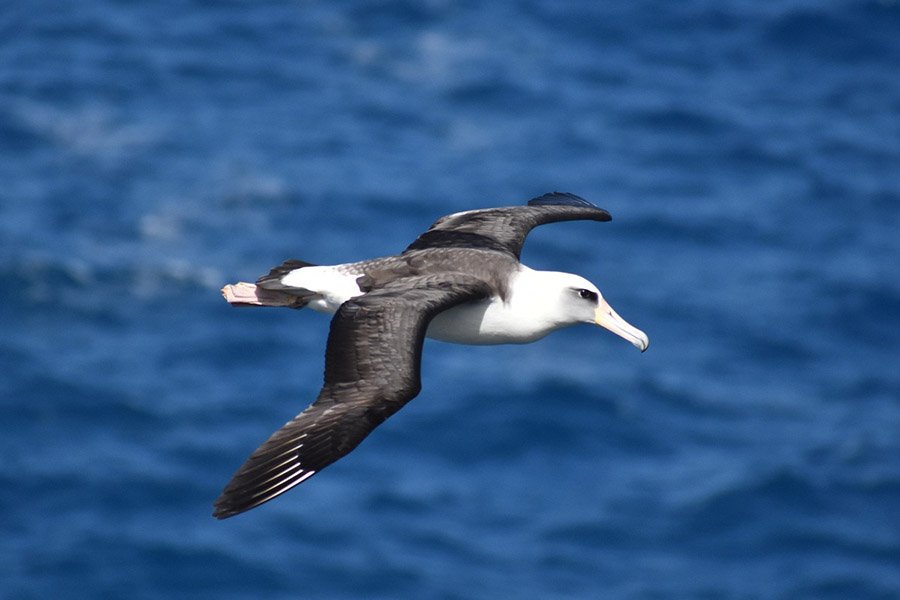
- Scientific name: Diomedea exulans
- Type of animal: Bird
- Where found: Southern Ocean
Our final destination brings us to the open seas, where we meet the Wandering Albatross, known for its enormous wingspan, reaching up to 11 feet, the largest of any living bird. These birds are mostly white with black wingtips and a blush of pink on their bill, allowing them to blend in with the sea’s frothy whitecaps while they soar over the waves.
Wandering Albatrosses are aptly named, as they spend most of their lives in flight, covering vast distances over the southern oceans. Their long, narrow wings are perfectly adapted for dynamic soaring, a flight style that takes advantage of wind speed and direction to glide effortlessly, expending little energy.
These albatrosses face numerous threats, primarily from longline fishing, where they are caught as bycatch. International cooperation is essential for their conservation, as these birds do not recognize country boundaries, and their survival depends on the health of the entire marine ecosystem.
